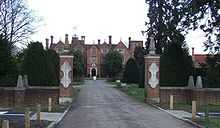Great Fosters
Coordinates: 51°24′58″N 0°32′42″W / 51.416°N 0.545°W

Great Fosters is a 16th-century mansion which originally lay within Windsor Great Park and is still adjacent to the town of Egham, Surrey, England. It is a Grade I listed building, close to Heathrow and the M25 London orbital motorway.
History
Great Fosters was the London seat of Sir John Dodderidge (1555-1628), a Judge of the King's Bench and formerly Solicitor General to King James I. He had been brought up in Barnstaple, in North Devon, and purchased the estate of Bremridge near South Molton, Devon, as his country estate. His epitaph on his monument in Exeter Cathedral states "He departed this lyfe at Forsters nere Egha(m) in Surrey". Sir Robert Foster owned the house in 1639. When he died in 1663 he left the house to his son, Sir Thomas Foster. Great Fosters remained in the family following his death in 1685 when it passed to his daughters. In 1715, Sir Charles Orbey resided here, and it was not until 1787 that one of Sir Thomas’ great grandsons sold the property to a Mr Wyatt for £700.
Early in the 20th century, Great Fosters was owned by Baroness Halkett, Queen Alexandra’s lady in waiting. Later it passed to the Earl of Dudley and then to the Hon. Gerald Montague. Today it is owned by the Sutcliffe family.[1]
The front of the house was used in the opening title sequence of the 1950s TV comedy series Whack-O! set at a minor public school. Also used in the Rank Organisation film about the Titanic A Night to Remember.
Frederick Furnivall was born at Egham, Surrey, the son of a surgeon who had made his fortune from running the Great Fosters lunatic asylum. Dr Furnivall had two other partners, one of whom was Sir John Chapman, one of the 300 founder members of the Royal College of Surgeons. Prior to the formation of this college, surgeons belonged to the Guild of Barbers and Surgeons. Sir John was one of “the modern thinkers” who believed that mental illness was not solely related to physical illness. No doubt his methods of treatment for mental illness were therefore quite revolutionary. Great Fosters thus became a lunatic asylum and despite this radical thinking he was described in local documentation as “Doctor to the Poor” in Windsor. It is believed, although not confirmed by Windsor Castle records, that Great Fosters was where King George III was housed when he was being treated for his insanity.
The house
In about 1550, the original house was built as a symmetrical U-shaped Elizabethan homestead. It is probable that it was extended in the early 17th century because there is slightly larger brickwork in the porch. It was at this time the initial tall chimneys were built. However, these pinnacles were removed during World War II after a bomb blast. They have been replaced by replicas.
A dominant feature of the house is the windows, all of which are stone mullions and transoms with leaded lights.
It is now a 4-star hotel.[2]